More and more people are choosing a more independent lifestyle. From green energy to various forms of subsistence farming, there are many ways of providing for yourself. One of the most popular options these days is goat farming. Even those new to all things agriculture are learning how to raise goats! As with anything new, it’s always important to do plenty of research before diving right in.
[the_ad_placement id=”in-text-1-type-r”]Raising goats goes beyond simply feeding and cleaning up after them. The better prepared you are, the better the results you will enjoy. It’s also good to prepare yourself for the benefits as well as possible problems that may occur from time to time.
Benefits of raising goats
When you decide to raise goats, it won’t take long to identify the many wonderful benefits. It’s important, however, to remember that how you raise goats for milk and how you raise goats for meat are quite different.
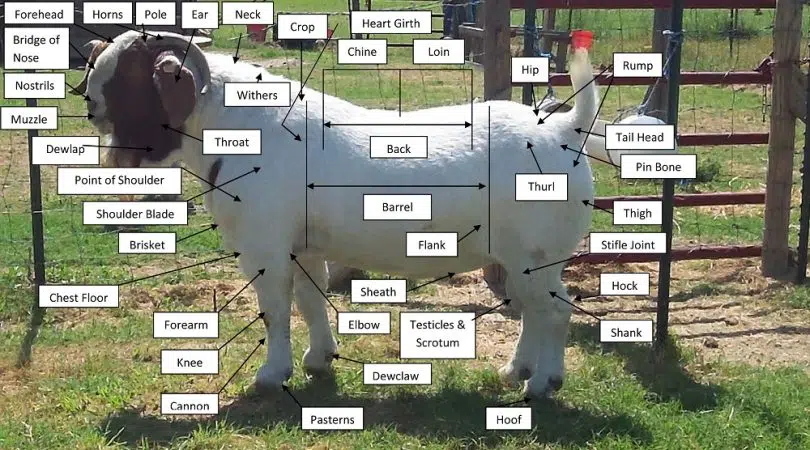
Specific measures must be taken in order to enjoy these benefits:
- Self-sufficiency thanks to a regular milk and/or meat supply.
- You can make your own cheese and milking can continue throughout the year.
- Pygora and Angora goats produce some of the most beautiful fibres, as do Cashmeres. You can make your own blankets or clothing items, or you can sell the fibres for profit.
- Goats can help you keep nasty weeds at bay which will reduce the need for herbicides.
- You can breed your goats to keep stocks up. Any extra babies can be sold.
- Goats can make great pets, and they can be trained to walk on a leash much like a dog. They can be wonderful company for adults and children.
- Goats can be trained to carry your belongings so, if you enjoy hiking, you can have them do most of the heavy lifting.
Nutritional benefits of goat milk
While researching how to raise goats for milk, you are bound to come across plenty of information regarding the benefits of this cow’s milk alternative.
- Goat’s milk is believed to have a beneficial reaction to inflammation, and this is why it is becoming increasingly popular.
- Goats take up a lot less space so, raising them is easy on the environment.
- Studies indicate that there is a connection between goat’s milk and increased iron and copper metabolized.
- Goat’s milk has a closer chemical makeup to human mother’s milk. It’s easier to digest, and the human body finds it easier to assimilate.
- The fat molecule size in goat’s milk is smaller than those found in cow’s milk. This means that the fat is easier for the body to digest.
- Cow’s milk has about 17% fatty acids while goat’s milk has about 35%. This makes it easier to digest, even for those with lactose intolerance.
- Cow’s milk is not the only source of calcium. Milk from goats is rich in calcium and the amino acid tryptophan.
- Goat’s milk does not aggravate mucous.
- Apart from being very high in calcium, it’s also rich in riboflavin, phosphorous, B12, potassium, and protein.
- Cows tend to be pumped with all sorts of growth hormones which affects the quality of the milk. These hormones are not used on smaller livestock like goats which makes the milk less toxic.
Nutritional benefits of goat meat
If you learn how to raise your goats for meat, you can enjoy a number of fantastic benefits for years to come. Not only can you rest assured knowing where your meat comes from, but you can also enjoy these nutritional benefits:
- Goat meat can lower the risk of inflammation in blood vessels and stabilize your heartbeat.
- Goat meat contains CLA which are fatty acids known to fight inflammation and prevent cancer.
- Rich in Vitamin B, this meat helps you burn fat. It’s also high in protein and low in saturated fat which is great for the waistline.
- Goat meat contains selenium and chlorine which also help prevent cancer.
- It helps prevent anaemia and improves blood circulation which makes it particularly beneficial for expecting mothers.
- Since it’s rich in B12, eating goat meat can reduce depression and stress.
- The Omega 3 Fatty Acids in meat offer several health benefits.
- Low in sodium and potassium, it’s great for controlling blood pressure and preventing stroke and kidney problems.
- The meat is also rich in calcium which is beneficial for obvious reasons.
Potential problems
When raising any kind of animal, it’s important to understand the possible problems that could come your way. No living being on this earth is entirely immune to illness and injury. There are complications that can occur from time to time and, by being properly prepared, you can treat these issues promptly and effectively. Firstly, it’s important to ensure that you feed your goats the right food or they could end up falling dreadfully ill.
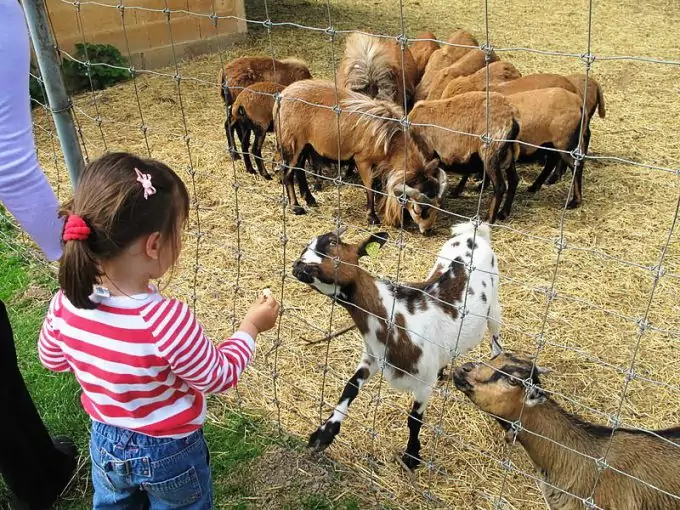
If you ever encounter the need to bottle-feed any of the babies, you should note that this can result in social problems within the herd. Bottle fed babies don’t seem to integrate quite as well. Worms and Coccidiosis are two of the most common problems as are foot problems. Persistent issues might mean that the animal will need to be culled or put down.
Goats also need the right living conditions, and they are known for being energetic and possibly even destructive. They are the type to snag your laundry off the line and destroy a fence or two so make sure that they are kept safe, and the risk of injury is kept to a minimum. In other words, you should “goat proof” the area much as you would “baby proof” your home.
Raising goats for different purposes
Goats can be raised for a number of reasons including meat and milk. Some people even raise show goats. The way in which you care for your goats is determined by your intentions for them.
Raising meat goats
The first important choice that you will need to make is the type of goat you choose to raise and breed.
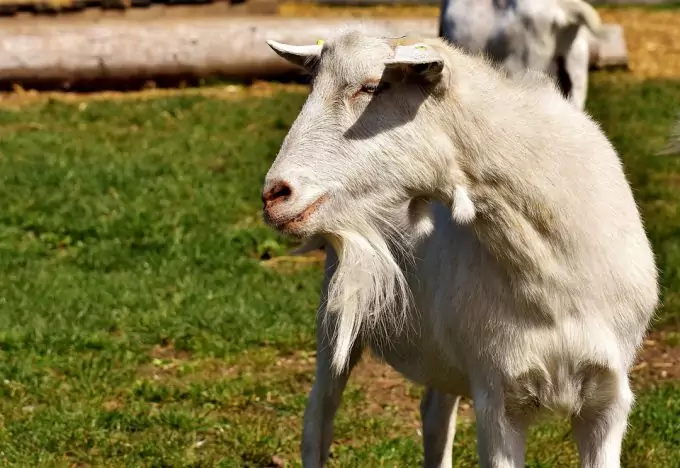
The meat goat should be mixed breeds while the bucks should be full breeds. Bucks can be somewhat temperamental and territorial so, if you don’t want to keep one permanently, you might be able to make a deal with somebody you know. If they have a buck, you could offer to pay them or provide them with a portion of the offspring.
Some breeds tend to put on weight faster than others (like the Boer breed). These breeds are the top choice for meat farmers because it means they will be able to reap the benefits sooner rather than later.
[the_ad_placement id=”in-text-2-type-r”]They will need a clean shelter that will protect them from the elements. The shelter should be cozy and not drafty. Remember, if you are planning on raising young in the colder months of winter, you will need to offer them extra protection from the cold. This is why so many people choose to keep their goats in a barn during such conditions.
You might need to keep various groups separate. As for food, you should provide them with plenty of forage foods like shrubs, grass, and even small trees. If food is scarce, you might need to supplement with pellets and hay. Obviously, they will need a clean water supply, and you should keep a close eye on them for illness or injury.
Do you need more options for other meat sources? Read our article on how to humanely raise pigs for meat for more information.
Raising milk goats
There are some breeds that are known for producing the best quality milk. Choosing the right breed will ensure that the milk has the most pleasant flavor without the musky aftertaste associated with some breeds.
The best dairy breeds include Alpine, Nubian, Sable, Saanen, and Nigerian Dwarf Goats. In order to get your goats to produce milk, you will need to breed them. You can milk the doe while she is pregnant but you should stop at least two months before she is due so that she can build up a rich and nutritious supply. Once the babies are about 2 weeks old, you can start milking her again. When the babies are about 8 weeks old, the doe’s milk production will reach its peak. You should be able to get ½ a gallon per day at this stage.
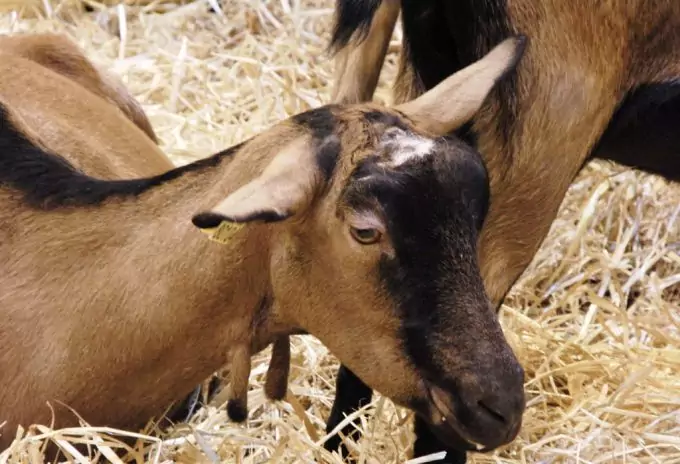
As it tapers off and the babies are weaned, you can milk your doe in the morning and at night. That said, you will only get about 1 ½ quarts of milk each day since her supply will be tapering off. After 9 months, you might only get about 2 cups a day. If you plan on rebreeding your doe, you should stop milking her at this point. If not, you can continue to obtain a small but steady supply of milk for as long as two years.
When milking the doe after she’s had her babies, you might be concerned about taking too much milk. The good news is that goats have a protective mechanism that won’t allow you to completely drain their supply! So, as you proceed, you will notice that the milk supply will become minimal at some point. This is when you should stop. You will see that her udder has not been completely emptied, and that’s perfectly fine since her young ones will need to feed from her for the first 8 weeks of their life.
Just like humans, they need liquid in order to produce liquid. They also need a highly nutritional diet in order to produce nutritional milk. So, make sure that you provide your does with plenty of variety in terms of their diet and keep fresh water readily available too.
Breeding
If you are interested in meat production, then you will need to ensure that you regularly renew your stock. Breeding is necessary in order to maintain a healthy number of bucks and does. You will need more does than bucks since one buck can breed with multiple does and produce healthy offspring.
As for milking, you will also need to breed your goats in order to stimulate the production of milk. When your does are in heat, it can last for just a few hours to a few days. In some cases it’s difficult to pick up on her heat cycle but, as you spend more time around these animals, you’ll get the hang of it.
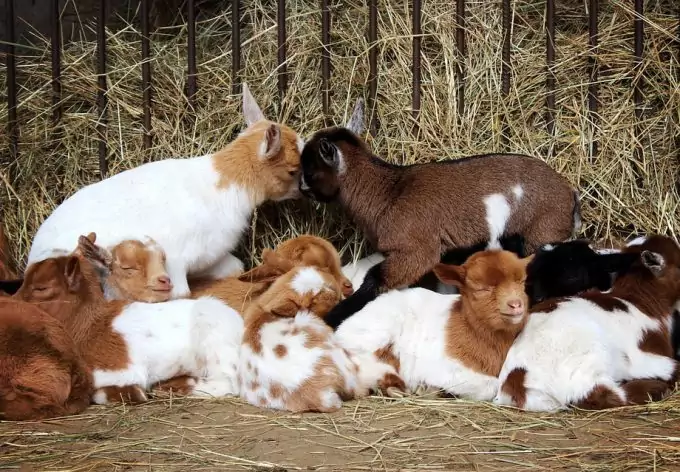
Look for signs like flagging (like a dog wags its tail), increased vocalization, a decrease in milk production, or even some proud parading around in search of some attention. Even if you don’t notice these signs, your buck sure will and he won’t hesitate once he gets the green light!
When bucks are in rut, they are ready to breed, and this is when they can present problematic behavior. Even when they are separated from the females, they can still fight with other bucks, and they tend to urinate on themselves as a sign to nearby females that they are ready. The smell might be unpleasant to us, but it attracts females, as does the dominant displays.
A single buck in rut can mate up to 20 times in a single day! As a result, it is important that you ensure that they have plenty of food and water. All the energy lost will need to be replaced and you can be sure that he will eat more than usual during this time.
Actual mating only lasts for a few seconds, and it’s best to leave the doe and buck together for some time. This way he will have several chances at getting it right. Just like any animal, fertilization might not occur on the first try so you should give them extra time to ensure best results. Watch your doe for signs of another heat. If she does not come into heat, then you can assume your buck was successful.
Once the doe is ready to welcome her babies, it’s important to keep the buck in a separate pen. He can be quite a nuisance when she is trying to give birth and, given his eager nature, he might breed with her prematurely. If this happens, it can stunt her milk supply and the babies are the ones who will suffer – along with the tired doe.
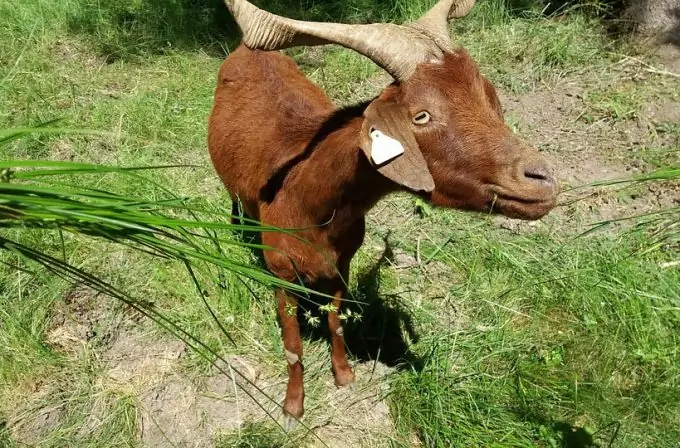
If you are planning on selling any of the babies, you should only do so after 8 weeks. During this time, do everything in your power to let them get to know you and become accustomed to human interaction. If you plan on keeping a few of them, this will make your life easier in the end. Plus, if you sell relatively tame baby goats, you will build up a positive reputation for yourself and buyers will surely return.
Medication to keep on hand
Unlike caring for a dog or cat, goats require more specialized attention at times. They are technically domestic animals, but they are also classified as livestock which means that what you put in is what you’ll get out at the end of the day. The better you care for your animals, the better quality meat, milk, and other products you will enjoy. If you notice a problem with any of your goats, it’s important to treat the issue immediately. This is why you must keep certain items on hand at all times and make sure that they are not expired!

Image credit: adventuresinthegoodland.blogspot.mk
If you can, you should invest in the appropriate microscope so that you can perform your own fecal analysis. Check samples from each animal on a regular basis and, when the eggs reach moderate to high levels, you will need to deworm them immediately. Some treatments are not safe for pregnant goats so take the necessary precautions in this regard. Coccidia treatments should also be on hand at all times. This bacterium is highly dangerous and can cause rapid dehydration so make sure that you treat without hesitation.
KaoPec is good for lining the stomach and protecting against the harmful effects of Coccidia and worms. If you don’t have this particular brand, ask your vet about alternatives. A lot of medications are administered according to the weight of the animal. Make sure that you keep basic supplies like a thermometer, weigh tape, needles, syringes, and drench syringes on hand.
Dispose of disposable items in the correct manner and make sure that you clean and disinfect any reusable supplies. Blood stop powder is ideal for the odd scratch and scrape. You should also keep animal safe disinfectants on hand like Betadine.
The best part about Betadine is that it kills germs without the sting! So you won’t traumatize the poor animal in the process. Broad spectrum antibiotics can be used to treat a number of ailments, and they are great for emergencies. That said, before administering such medication, make sure that you consult with your local vet first.
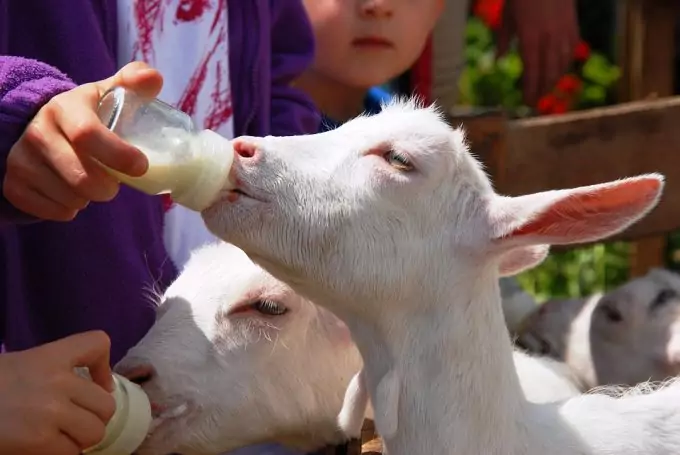
Just like humans, goats can also develop milk fever so, before you start breeding, make sure that you understand the symptoms and keep a form of treatment on hand. Goats can also eat too much from time to time so you should also keep some kind of bloating relief medication on hand just in case. Benadryl works well in the event of an allergic reaction or sting but make sure that you ask your vet first.
Vitamin B supplements will also benefit your goats by boosting their immune system and improving their appetite. Goats can also suffer from mastitis which is why you should keep some test cards on hand. You cannot perform the test yourself but, if you have the cards, you can gather a sample and send it away without delays. E.coli is a nasty bacterium that can lead to problems in animals and humans.
If you notice gastrointestinal issues, it could be E.coli. Fast treatment is essential, and you never can tell when such an infection could occur (day, night, weekends, holidays, etc.). Make sure that you keep an over the counter antibiotic on hand for this reason. Of course, bandages are also good to have and make sure that you always wear sterile gloves. Check your supplies regularly to make sure that they are not expired or close to the expiration date. Replace each item as needed.
Lifespan and euthanasia
No matter what type of animal you raise or breed, there’s always a lifespan. A baby will reach sexual maturity at a certain point and breeding will be possible for a particular period of time before the animal will no longer be able to produce young.
Goats are known to live as long as 12 years, and bucks usually have a shorter lifespan than does. If you plan on breeding regularly, it’s important to understand that birth defects may occur from time to time. Many of which cannot be corrected and, for the sake of the animal, it’s best to have them euthanized. Cleft palates and atresia ani (the lack of a rectal opening) are two noticeable defects.
[the_ad_placement id=”in-text-3-type-r”]If a goat is severely injured or too old to lead a comfortable life, the humane thing to do is to have them put down. It’s never fair to let any animal suffer for the sake of human gain. While it’s painful to think of letting them go, it really is the kindest thing to do.
Protecting the herd
Goats are ruminants, and they are in no way predators. It’s this very nature that can make them vulnerable to various forms or prey. Bucks tend to become rather territorial and protective when they are in “breeding mode” but this doesn’t mean that they really stand a chance.
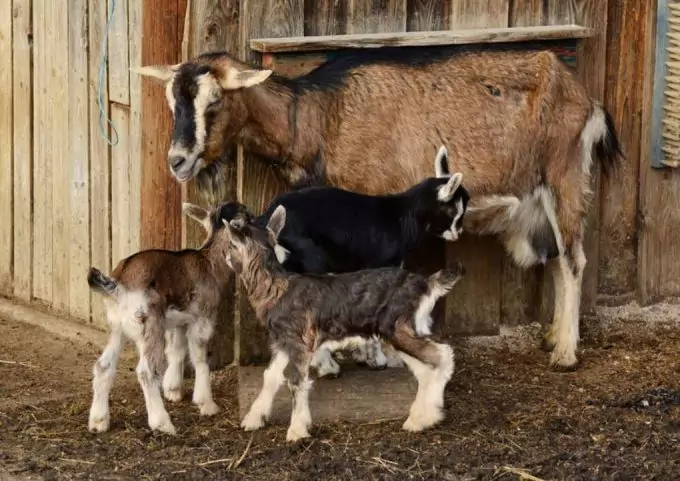
Some common enemies include dogs, coyotes, cougars, wolves, foxes, and even some large birds that prey on newborn young and old or ailing adults. Keep your herd safe by maintaining their enclosed area. High fences need to be kept in top shape with solid foundations to prevent digging. To better see predators that may be lurking at night, read our article reviews of the best night vision binoculars to help you.
Guardian animals like a trained dog or two can also help your cause. Finally, don’t forget to leave them to roam. Tethering them will only put them in more danger since they cannot flee from predators.






You can also use goat’s droppings as compost for your garden and if you have a sizable herd, you can turn the waste into raw materials for a small biomass farm which can supplement your farm’s electrical needs and take care of the waste processing as well.
Raising a goat needs a lot of research. They look cute and awesome but they are defenseless. Is it true they need to be disbudded? I don’t know which is crueler; disbudding a kid goat or letting them harmed by other predators because their horns stuck in the fence? I heard that a lot of goats die because they were unable to defend themselves. What do you think?
Do you have any advice when it comes to preventing heat exhaustion?
I live in a hot area and wanted to raise goats for a while, but this could be a problem.
Is it true that goats, apart from providing valuable resources, maintain the lawn as well? It’s extremely convenient, as they would have a large amount of grass to munch on, and I would not have to maintain the yard as much as I do now.
A goat could trim a lawn, in some very specific circumstances.